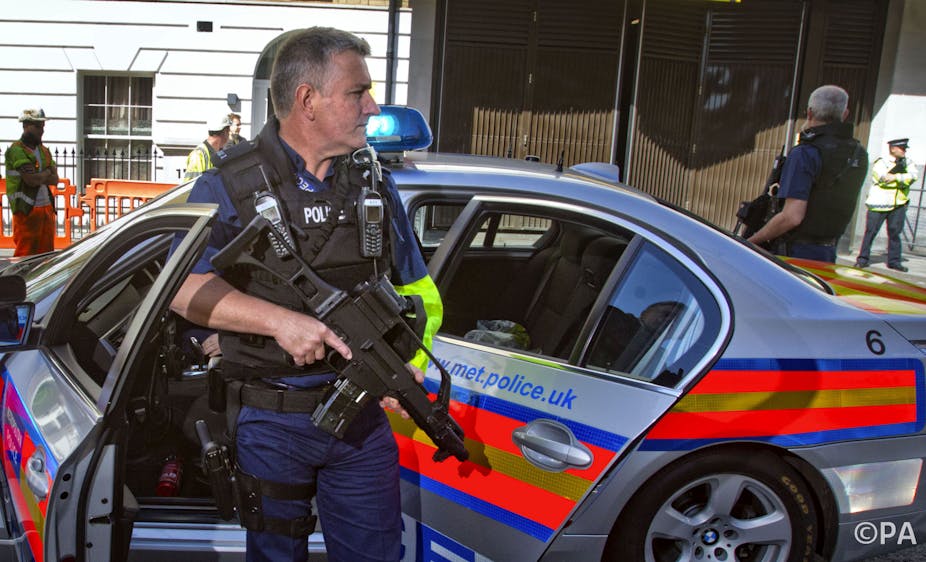Two violent incidents, a murder and a home invasion, took place just a few miles apart in North London last week. In both cases, armed police were sent to the scene but to very different ends. At the first incident, the suspect was tasered and arrested and at the second, the alleged attacker was shot and killed.
Despite the different results, the apparent similarities of the two incidents have led some to question the different policing tactics employed.
Police armed response officers are equipped with a range of potentially lethal and less lethal weapons. These weapons provide officers with a flexible range of options. It’s a continuum designed to allow them to use the minimum necessary force to protect members of the public and themselves.
Ultimately, though, the weapon used to tackle a suspect often comes down to a split-second judgement on the part of an officer at the scene. Armed response officers are highly trained and professional and their judgement, repeatedly honed in many simulations and exercises, is critical. Yet a simulation can never replicate the dangers of a real event and clear thinking in the adrenalin rush of the moment is critical. Armed policing is the most difficult job police officers will ever have to undertake.
In the first of the recent incidents, police were called to Enfield following the suspected beheading of an elderly woman by a man wielding what was described as a machete. On confronting the man, a scuffle broke out and the police used a taser on him before arresting him.
The following evening, a man was reported to have broken into a house in Islington at about 11pm and threatened a woman with a knife. Armed officers and a police negotiator went to the scene but at about 1am neighbours reported hearing gunshots. The man died on the way to hospital.
Many factors can account for the differences in police response, particularly the immediate threat posed by the suspect and what they appear to be doing. Shooting them is always a last resort.
Officers are extensively schooled in assessing the proportionality of the risk and the terms of the Human Rights Act as they relate to the suspect. In the perverse language of “shooting to kill to protect” every pull of the trigger is supposed to be “human rights compliant”.
Yet if police are to take on the awesome responsibility of shooting at another human being, it is because they perceive that person as representing an immediate threat to the life of another. In these circumstances they do not have the luxury of shooting to warn or to wound – they shoot at the torso with the aim of stopping or incapacitating the offender and neutralising the threat. But for obvious reasons shooting anyone in this area is highly likely to be fatal.
Police are more likely to shoot if the suspect is known to be armed and dangerous, or if they are known to have attacked police. They are also more likely to shoot if the situation is out of control, if they have to rush to the scene and if they end up suddenly confronting a suspect rather than establishing a containment perimeter. Some research has even found that officers having drunk a large amount of coffee were more likely to shoot. Other US research, has found they are more likely to shoot if the suspect they face is black – a trend that is rather concerning given recent events in Missouri.
Back in Britain, research by the Police Complaints Authority found that the Metropolitan police were more likely to shoot – per armed deployment – than other mainland British forces
There are situational factors involved: if officers feel personally threatened, if suspects fail to respond quickly to police instructions, or seem to behaving erratically, police are more likely to shoot. Such factors go some way to explaining the disproportionate numbers of suspects experiencing mental disorders, or those under the influence of drink or drugs, who are shot by the police. Poor visibility may also be an issue, with suspects more likely to be shot during the hours of darkness.
In all of this it is important to recognise that armed police have been deployed thousands of times in the UK over the years but have rarely discharged their weapons. In the period 2008-2012, police officers fired their weapons only nine times. There were just two fatalities in 12,500 deployments in 2011-12 and none in 2012-13.
When police do shoot, it is invariably newsworthy and controversial. The recent debates about the shootings of Azelle Rodney (deemed unlawful by a judicial inquiry in 2013) and Mark Duggan are proof of this.
But of recent police shootings, perhaps none expose the difficult dilemmas and critical decision-making facing police officers more than the shooting of David Sycamore in Guildford in 2008.
Police had been alerted to an armed man seemingly drunk and depressed. When confronting him, he pulled what later turned out to be a replica semi-automatic pistol from his jacket and pointed it at the approaching police. Two officers fired near simultaneously, one with a baton round (plastic bullet) the other with two rounds from a HK G360 police specification assault rifle. Sycamore was killed.
The fact that two officers in almost identical situations can reach such different decisions about how to respond to a perceived threat, speaks volumes about the difficulty of the split-second judgement. It also serves as an important lesson for commentators – it is so much easier to rule on these incidents with the benefit of hindsight.

